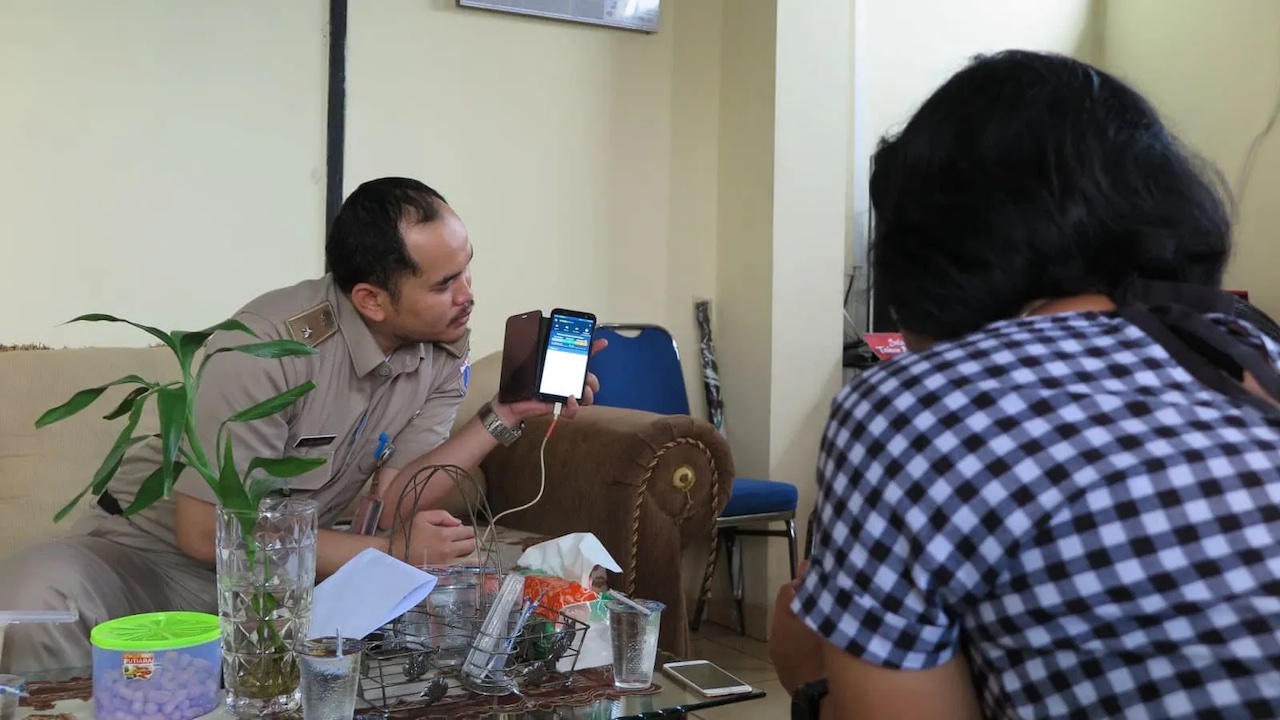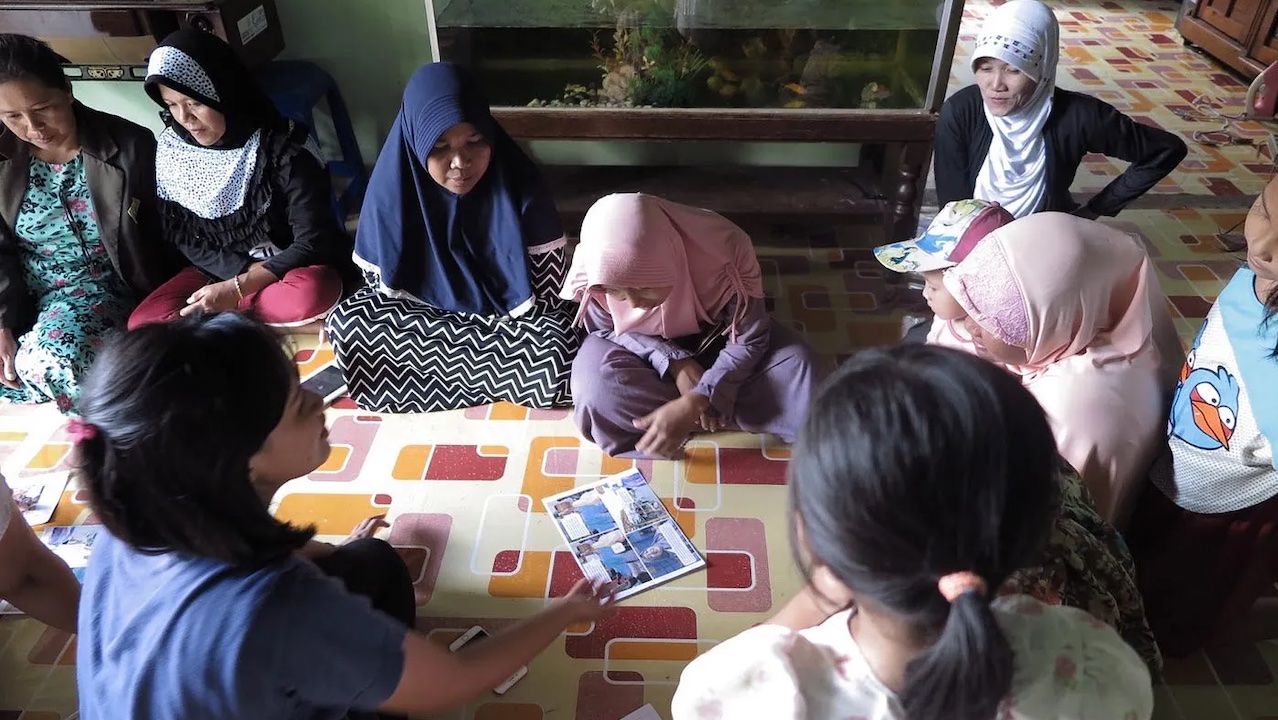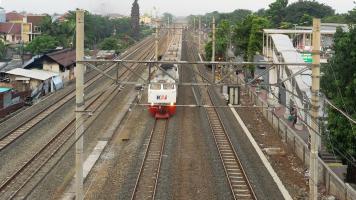Designing a Community-Based Air Quality Monitoring System to Mitigate Air Pollution Health Risks

Research Coordinator, UN Pulse Lab Jakarta

Former Communication Manager, Pulse Lab Jakarta

Designing a human-centered air quality monitoring system entails understanding the experiences and perceptions of communities and local governments. Photo credit: Courtesy of Pulse Lab Jakarta.
Thanks to its people-centered design, the system was able to disseminate reliable and timely information on air quality to users.
This story is published in collaboration with Pulse Lab Jakarta.
In some communities across Indonesia, air pollution poses a threat to the health of residents, particularly children. In Kalimantan and Sumatera for example where forest and peatland fires are frequent occurrences, UNICEF estimates that nearly 10 million children are at risk. Although a range of short- and long-term respiratory symptoms and illnesses are known, many vulnerable communities do not always know when and what precautions to take to limit their exposure to poor air quality. To encourage mitigating actions at the community level, Kopernik, an R&D lab for social and environmental issues, approached Pulse Lab Jakarta to help design and pilot a user-centric system that leverages air quality data and applies human-centered design principles. This mixed-methods approach focuses on the role of human intermediaries within communities to share reliable, actionable, and contextual information, particularly among vulnerable groups.
Understanding the experiences and needs of potential users
In applying human-centered design as a problem-solving approach, our first step was to understand the experiences and perceptions of communities and local governments that regularly deal with air pollution. Our research brought us to Galur in Central Jakarta, as well as Desa Rasau Jaya III in West Kalimantan. Having completed most of the field research prior to the onset of the COVID-19 pandemic, we had the opportunity to meet and speak with potential users within these communities from their homes, schools, and workplaces. Our goal was to better understand their needs, desires, and pain points to inform the design of an air quality monitoring system for direct use by the community.
From our interviews and observations, we found the following insights the be the most salient:
- Air pollution is not often perceived as a priority for village apparatus and community members, because from their standpoint it rarely results in immediate health effects or causes massive disruption of activities.
- In order for air pollution-related health information to lead to behavior change, continuous and specific support is needed from village apparatus and health cadres within the communities.
- Context-specific information on what to do and when to take action is critical to encourage mitigating actions at the community level.
- While there is an abundance of smartphone users, some residents tend to rely on offline/traditional channels to receive air pollution-related health information from the village apparatus.
These insights combined with several rounds of ideation and discussion, allowed us to develop the core features of an air quality monitoring system design that is able to disseminate reliable and timely information on air quality to users as human intermediaries within communities, as well as providing actionable and contextual information in a user-friendly way to help mitigate related health risks.
Turning insights into actions
With the goal of turning these insights into actions, a prototype was designed consisting of three main components:
- Low-cost air quality sensors (costing under $300 each);
- A data visualization dashboard that computes the air quality index and provides recommendations on what actions to take, enhanced with a notification feature to send alerts whenever the air quality reaches certain thresholds; and
- A dissemination toolkit that leverages existing offline and online information sharing channels in the community.
The system relies on sensors to gather air quality data from the two locations where the prototype was being piloted: Galur, Central Jakarta (an urban area where vehicles and small industries are sources of air pollution) and Rasau Jaya, West Kalimantan (a rural area where annual forest fires are common). Prior to installing these sensors, the Udara Project team at Institut Teknologi Bandung (one of the research partners) validated the sensors’ performance over several weeks, assessing their accuracy, precision, and suitability for use in the local environmental context. To calculate the air quality index, the research team was guided by the terms outlined in the Indonesian Ministry of Environment and Forestry’s regulation regarding measuring the air quality index.
As part of the project, the team set up a public-facing portal to present the air quality index in a user-friendly and intuitive manner. During its remote usability testing, the need to further simplify the information architecture was emphasized. In particular, this was to ensure that the information presented could be easily understood by the two target profiles: the users and the beneficiaries. Those who make up the village apparatus are seen as the main users and are best positioned to operate and maintain the system. On the other hand, members of the community are seen as the beneficiaries who will use the information to become more proactive and advocate for better protective measures
The village apparatus has the ability to monitor air quality in their respective areas, which is particularly useful whenever the system issues an alert. Once the air quality measure reaches a certain threshold, the system will send an alert to users through a web browser notification. The village apparatus on the receiving end then shares the information with human intermediaries on the ground, who are typically community leaders and health officials. From here, the information about the air quality is further disseminated either online (such as via WhatsApp groups) or by way of direct visits to communities to raise awareness among residents. A set of recommended actions on how to mitigate the health risks are also provided, which are specific to the local context and the needs of certain key beneficiaries in the areas.

Potential to refine and scale
From our initial desk review and consequent user research in Galur and Rasau Jaya, we knew that there were a handful of existing systems that provide air quality information. However, many of these are primarily online systems that serve people with smartphones in megacities. In essence, they typically lack the offline component needed to ensure no one is left behind, especially when critical information on poor air quality is being circulated.
The prototype we designed seeks to leverage health socialization nodes in the community, for instance via Posyandu (health post managed by the community) and PKK (Pemberdayaan Kesejahteraan Keluarga—a local community-building network primarily run by women), by creating pathways to connect online and offline channels. The offline network of human intermediaries is important for creating a more inclusive system that can allow everyone to access information, including those who do not have access to smartphones and the internet. Beyond ensuring that the air quality information is accessible, it is also important to improve the village apparatus and community members’ knowledge of the short- and long-term health effects of air pollution by engaging them in learning activities and through informational products.
By design, the prototype was developed to be easily operated with minimal maintenance. However, it has potential for further development, with the integration of additional functionalities based on the needs of users that may arise. Given the recent Ministry of Environment and Forestry regulation P14/2020, requiring local governments to provide information on air quality within their areas, the design and infrastructure of this system can be built on to provide more timely and reliable air quality information within communities.
Air pollution remains a major concern in communities across Indonesia, and having an agile community-based air quality monitoring system that combines data analytics with human-centered design has an added advantage. How might we further improve this system to ensure that everyone has access to air quality information and knowledge on the course of action that needs to be taken?
This article was first published by Pulse Lab Jakarta on Medium on 1 July 2021.
Pulse Lab Jakarta partnered with Kopernik and Institut Teknologi Bandung Udara Project and received funding from the Islamic Development Bank for the project.

Aaron Situmorang
Research Coordinator, UN Pulse Lab JakartaAs research coordinator at UN Pulse Lab Jakarta, Aaron Situmorang focuses on service design, digital transformation, and future foresights.

Dwayne Carruthers
Former Communication Manager, Pulse Lab JakartaDwayne Carruthers works as the public advocacy manager at UN Global Pulse through Pulse Lab Jakarta, advocating for the adoption and responsible use of data and AI for evidence-based decision-making in the public sector. He is concurrently the global communications lead of the Global South AI4COVID program. His work has focused on exploring the intersection between people and technology, and pulls from his background in journalism, international law, and diplomacy.

UN Global Pulse Asia Pacific Hub
UN Global Pulse is the United Nations Secretary-General’s innovation lab. The Asia Pacific Hub is designed to run portfolios of on-the-ground innovation projects that apply data, digital, foresight and behavioral science methods to regional issues. The hub builds on the successful partnership model that spans over 10 years between the UN and the Government of Indonesia under the Pulse Lab Jakarta portfolio.
Visit our Knowledge Hub at http://knowledgehub.pulselabjakarta.org/.


